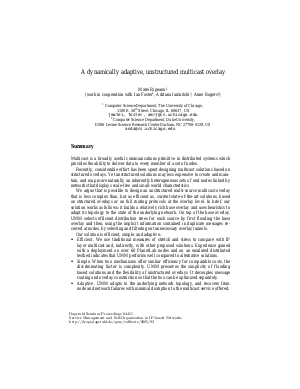A dynamically adaptive, unstructured multicast overlay
Authors Matei Ripeanu, Ian Foster, Adriana Iamnitchi, Anne Rogers
-
Part of:
Volume:
Dagstuhl Seminar Proceedings, Volume 4411
Part of: Series: Dagstuhl Seminar Proceedings (DagSemProc) - License:
 Creative Commons Attribution 4.0 International license
Creative Commons Attribution 4.0 International license
- Publication Date: 2005-03-24
File

PDF
DagSemProc.04411.3.pdf
- Filesize: 37 kB
- 1 pages
Document Identifiers
Subject Classification
Keywords
- multicast overlay
- self-organization
Metrics
- Access Statistics
-
Total Accesses (updated on a weekly basis)
0Document
0Metadata
Abstract
The simplicity of multicast as a communication primitive belies its broad utility as a building block for distributed applications. Nevertheless, creating and maintaining multicast structures can be challenging, particularly when networks are transient and/or dynamic. We introduce a new unstructured multi-source multicast (UMM) overlay approach that we argue is less complex than, but as efficient as, current state-of-the-art solutions based either on structured overlays or on running full routing protocols at the overlay level. UMM builds a base overlay independently from the routing mechanisms employed to route messages. On top of this base overlay, it selects distribution trees for each multicast source by first flooding the base overlay and then using the implicit information contained in duplicated messages to select and filter out redundant tunnels. Simple heuristics are used to maintain and evolve both the base overlay and the multicast distribution trees in response to changes in the set of overlay participants or in underlying network conditions. We experiment on a 65-node PlanetLab deployment and on ModelNet emulated distributed platforms to quantify the overheads associated with UMM operation and to explore its performance and adaptability to changes in the underlying network conditions.
Cite As Get BibTex
Matei Ripeanu, Ian Foster, Adriana Iamnitchi, and Anne Rogers. A dynamically adaptive, unstructured multicast overlay. In Service Management and Self-Organization in IP-based Networks. Dagstuhl Seminar Proceedings, Volume 4411, p. 1, Schloss Dagstuhl – Leibniz-Zentrum für Informatik (2005)
https://doi.org/10.4230/DagSemProc.04411.3
BibTex
@InProceedings{ripeanu_et_al:DagSemProc.04411.3,
author = {Ripeanu, Matei and Foster, Ian and Iamnitchi, Adriana and Rogers, Anne},
title = {{A dynamically adaptive, unstructured multicast overlay}},
booktitle = {Service Management and Self-Organization in IP-based Networks},
pages = {1--1},
series = {Dagstuhl Seminar Proceedings (DagSemProc)},
ISSN = {1862-4405},
year = {2005},
volume = {4411},
editor = {Matthias Bossardt and Georg Carle and D. Hutchison and Hermann de Meer and Bernhard Plattner},
publisher = {Schloss Dagstuhl -- Leibniz-Zentrum f{\"u}r Informatik},
address = {Dagstuhl, Germany},
URL = {https://drops.dagstuhl.de/entities/document/10.4230/DagSemProc.04411.3},
URN = {urn:nbn:de:0030-drops-938},
doi = {10.4230/DagSemProc.04411.3},
annote = {Keywords: multicast overlay , self-organization}
}
